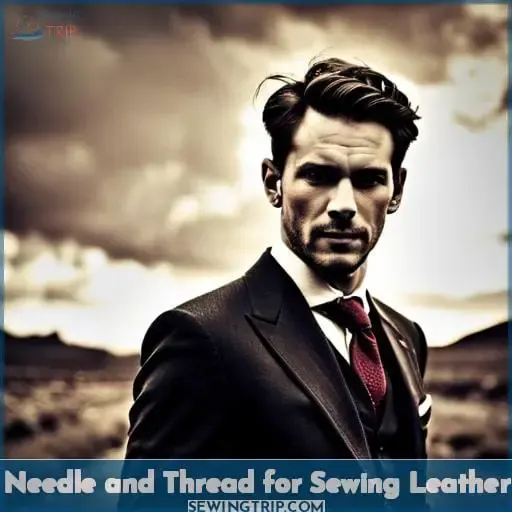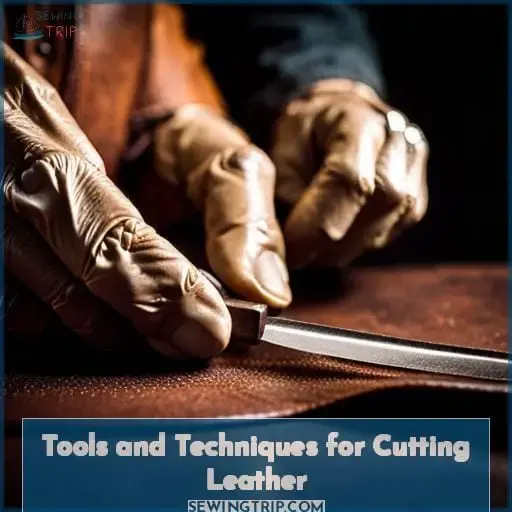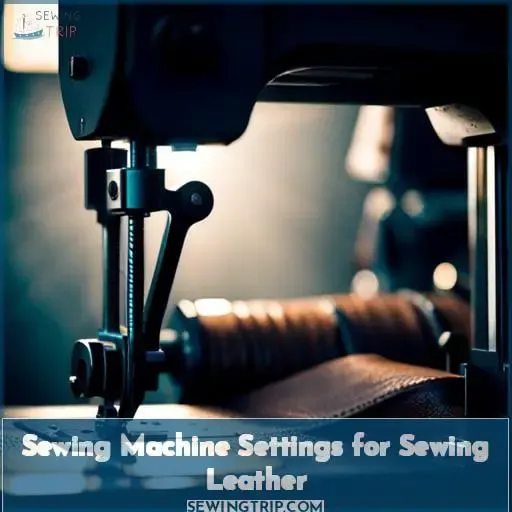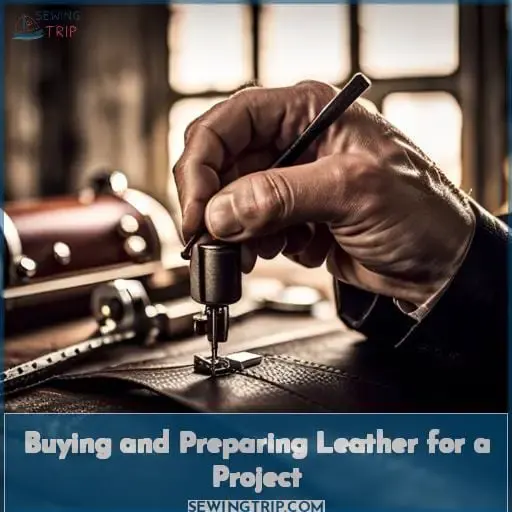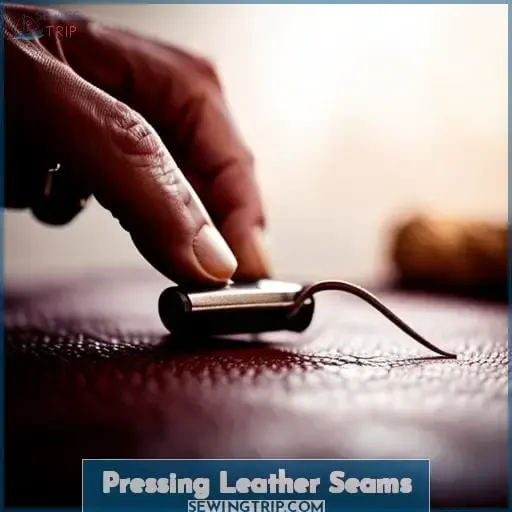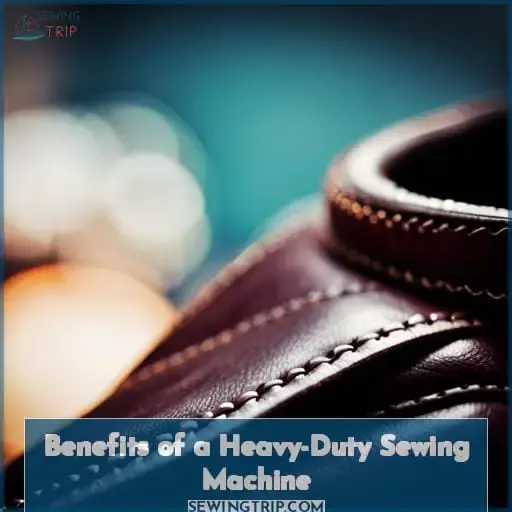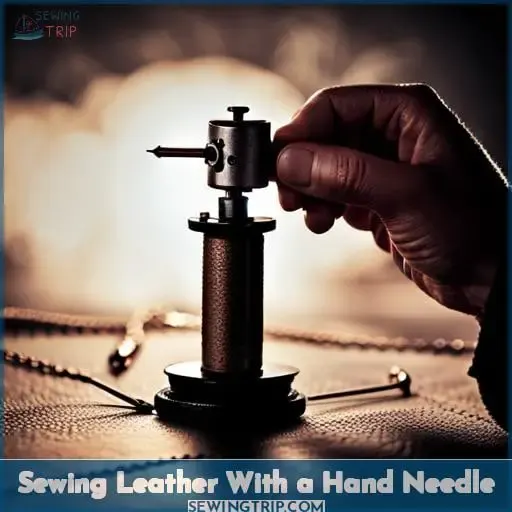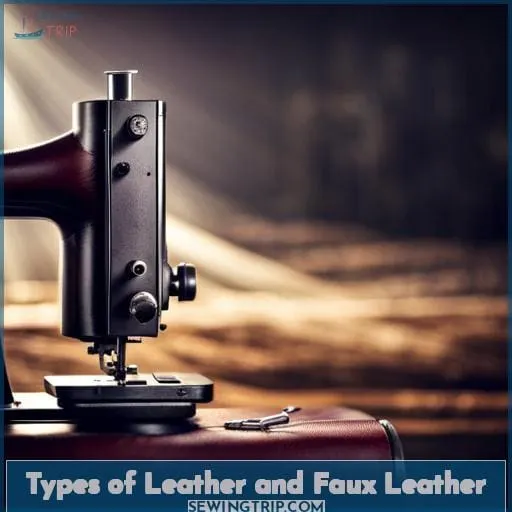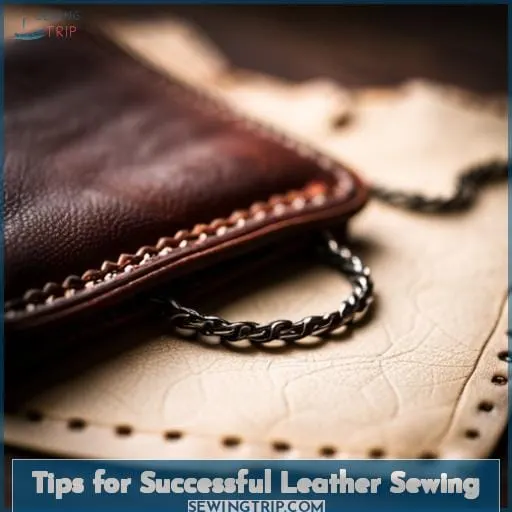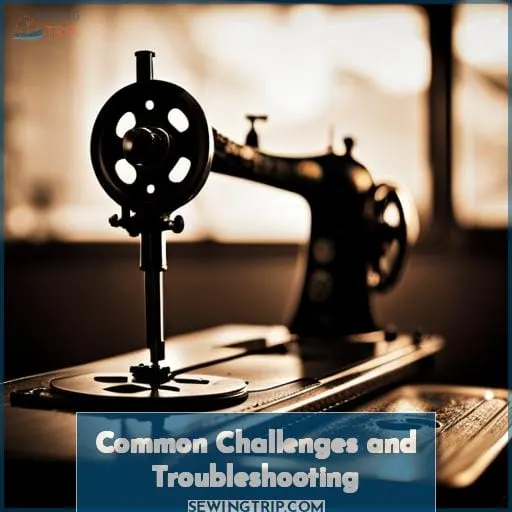This site is supported by our readers. We may earn a commission, at no cost to you, if you purchase through links.
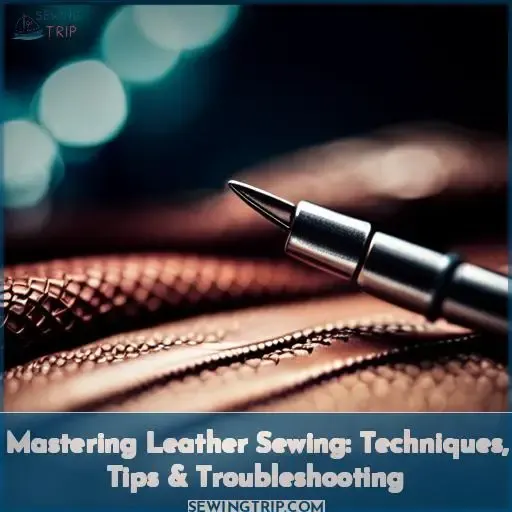 Unraveling the intricacies of crafting with leather opens the gateway to a realm where your creativity stitches seamlessly with mastery. As you embark on the journey of sewing leather, a material that exudes elegance and durability, you’ll find yourself drawn into the enchanting world of techniques, tips, and troubleshooting.
Unraveling the intricacies of crafting with leather opens the gateway to a realm where your creativity stitches seamlessly with mastery. As you embark on the journey of sewing leather, a material that exudes elegance and durability, you’ll find yourself drawn into the enchanting world of techniques, tips, and troubleshooting.
Just as a skilled artist wields a brush, you will navigate the challenges and joys of leather sewing with precision. Each stitch will be a testament to your growing expertise. Imagine holding in your hands the supple yet resilient fabric that is leather, an artisanal playground where your dreams take shape.
Whether you’re diving into the realm of hand-stitched finesse or harnessing the power of your trusted sewing machine, the path to success lies in your grasp. As you thread your needle through layers of history and innovation, you’ll unravel the secrets of choosing the perfect thread and gliding through notions like a seasoned craftsman.
With bated breath, you’ll discover how to wield cutting tools like a maestro, crafting shapes with precision. And when the hum of the sewing machine becomes your muse, you’ll unlock the symphony of machine settings.
Adjusting tensions and stitch lengths as if choreographing a dance between thread and leather.
From selecting the finest leather pieces to pressing seams with an artisan’s touch, every facet of your journey resonates with the rhythm of your newfound expertise. Step into the world of leather sewing – where control, creativity, and mastery await your skillful touch.
Table Of Contents
- Key Takeaways
- Needle and Thread for Sewing Leather
- Tools and Techniques for Cutting Leather
- Sewing Machine Settings for Sewing Leather
- Buying and Preparing Leather for a Project
- Pressing Leather Seams
- Benefits of a Heavy-Duty Sewing Machine
- Sewing Leather With a Hand Needle
- Types of Leather and Faux Leather
- Tips for Successful Leather Sewing
- Common Challenges and Troubleshooting
- Frequently Asked Questions (FAQs)
- Conclusion
Key Takeaways
- Sewing leather demands precision and troubleshooting skills.
- Mastery in leather sewing requires proper tools and techniques.
- Adjust sewing machine settings for precise leather sewing.
- Troubleshoot stitch holes and needle breaks with tension adjustments.
Needle and Thread for Sewing Leather
Introducing your gateway to flawless leather sewing: a journey through Special Sewing Machine Presser Feet, the art of selecting the perfect thread for leather, and the ingenious notions that ensure secure basting of leather pieces.
With expert insights at your fingertips, navigate the intricacies of sewing leather with precision, confidence, and an artisan’s touch.
Special Sewing Machine Presser Feet
Discover how the Zigzag Teflon Sewing Presser Foot takes your sewing experience to the next level, effortlessly handling a variety of materials with its non-stick design. This grants you creative freedom to experiment with stitch styles and ensures a smooth feed for precision results.
Benefit from the Teflon Foot’s non-stick surface for easy gliding over leather seams.
Maintain your sewing machine’s performance by regularly cleaning and oiling it.
Enjoy the convenience of an advanced needle threader that saves time and reduces eye strain.
Let this tool inspire you in your leather crafting journey, unlocking new possibilities.
Elevate your sewing projects with this versatile presser foot and unleash your creativity on any heavy-duty fabric.
Choosing the Right Thread for Leather
Explore the intricacies of selecting the ideal thread for your leather projects, just like a painter carefully choosing their vibrant palette to evoke a spectrum of emotions. Thread selection is more than functional; it’s an art form that affects stitch appearance and longevity.
Navigate the nuances of thread tension variations, considering leather’s unique demands. Factor in needle size to ensure your stitches form flawlessly, making adjustments for stitch origin. Mastering these subtleties empowers you to orchestrate stunning leather creations.
Notions for Basting Leather Pieces
Delve into the world of crafting precision as you explore the essential role of specialized notions in securing your leather pieces effortlessly. Experience efficient stitch marking and secure joining methods with alternative pinning approaches.
Discover precision basting solutions that elevate your leather sewing game. These techniques, combined with leather sewing needles, cutting tools, and careful leather preparation, ensure impeccable leather seams for your projects.
Tools and Techniques for Cutting Leather
Delve into the world of leather crafting with a focus on cutting precision and preparation techniques. Discover an array of cutting tools tailored for leather and learn how to ready your leather canvas for immaculate results.
From the perfect blade to meticulous prepping, this segment unveils the essential aspects of crafting with leather, ensuring your projects come to life with finesse and flair.
Types of Cutting Tools for Leather
Take a moment to consider the various cutting tools available that can help you master the art of working with leather. From sharp shears to rotary cutters, these tools are essential for achieving precise cuts and bringing your leather crafting projects to life.
Sharp shears offer a straightforward approach, ideal for straight lines. Meanwhile, rotary cutters excel in intricate cuts and curved edges, perfect for leather crafting intricacies. Your choice depends on your project’s demands and your desire for mastery in leather cutting techniques.
So, explore these tools, embrace leather edge finishing, and unlock endless leather embellishment ideas while ensuring precision with the right cutting tool for your craft.
Preparing Leather for Cutting
Discover the essential steps for preparing your leather pieces before cutting, ensuring a seamless and satisfying crafting experience. Consider lining considerations as thin, firm linings might impact your stitches.
Experiment with the wetting technique to make leather more pliable and easier to cut. Plan pattern placement meticulously, accounting for defects and maximizing material usage. Explore adhesive options like water-based super glue for precise seam finishing.
Don’t hesitate to experiment with stitching on scrap leather to fine-tune your settings for the best results.
Sewing Machine Settings for Sewing Leather
Delve into the intricacies of sewing leather with finesse by navigating the realm of tension adjustment and refining stitch length. Elevate your leathercraft prowess further by embracing the power of a Walking Foot or Even Feed Foot, ensuring a harmonious marriage of fabric layers and smooth, consistent stitches that resonate with professional craftsmanship.
Adjusting Tension and Stitch Length
Now, let’s dive into adjusting tension and stitch length, fine-tuning your machine settings for that perfect stitching rhythm on your leather creations. Achieving impeccable stitches on leather demands a delicate balance. Set the tension to match the leather thickness; find that sweet spot where the thread embraces the leather without puckering or pulling.
Experiment with stitch length – use shorter stitches for tighter seams and longer ones for visible elegance. Consider conducting a wetting leather experiment; moisture can ease stitching. Troubleshooting backside stitches? Focus on tension and needle interaction.
Your journey to mastering leather sewing is as intricate as the stitches themselves.
Using a Walking Foot or Even Feed Foot
Supercharge your stitching prowess by embracing the unstoppable force of a Walking Foot or Even Feed Foot – the dynamic duo that ensures your fabric feeds like a dream, leaving uneven stitches and frustrations far behind! Stitching precision becomes your loyal companion as these presser feet synchronize layers flawlessly, even on thick fabrics like leather.
Seam reinforcement gains a new dimension, offering the confidence to tackle any project with finesse. Experience the leather compatibility, and let the advantages of the Walking Foot elevate your sewing endeavors to unmatched levels of mastery and control.
Buying and Preparing Leather for a Project
Embarking on a new leather crafting project? Dive into the world of precision and creativity by deciphering the art of calculating your leather requirements and sourcing top-notch leather. Unravel the secrets of estimating just the right amount of leather for your endeavor, while uncovering the finest destinations to acquire premium-quality hides.
Calculating How Much Leather You Need
Explore how to accurately determine the amount of leather needed for your project, ensuring you have the right materials to bring your creative vision to life. Calculating leather yardage involves considering factors like leather types, thickness, and the intricacy of your leather craft patterns.
Real leather varies in thickness, so measure it using a leather thickness guide. Take into account the leather stitching techniques you’ll use and your leather sewing machine’s capabilities, like the Singer 4423 for heavy-duty tasks.
These sewing tips empower you to master your project with precision and control.
Where to Buy High-Quality Leather
When it comes to purchasing top-notch leather for your crafting endeavors, your go-to source is essential for securing materials that elevate your projects to the next level. Sourcing suppliers who specialize in premium leather grades ensures the foundation of your creations is of the highest quality.
The right supplier not only provides top-grade leather but also offers valuable advice on tool selection, material alternatives, and even leathercraft workshops. This empowers you with the mastery and control needed to create stunning leather garments using techniques like hand sewing and leather glues.
Pressing Leather Seams
Introducing a crucial technique in your leather crafting journey: Pressing Leather Seams. Discover the art of using a Leather Pressing Tool to achieve polished and professional results. Get ready to delve into valuable tips that will empower you to master the skill of pressing leather seams flawlessly, elevating the quality of your leather creations with finesse and expertise.
Using a Leather Pressing Tool
Elevate your craftsmanship with the finesse of using a leather pressing tool that enhances the precision and quality of your finished pieces. Discover the benefits of the Teflon foot, designed for smooth stitching on delicate materials like leather.
Explore the nuances of leather seam pressing, comparing different adhesives and dye techniques. Understand the effects of wetting leather and how it influences the final result of your leather crafting projects.
Master the art of leather topstitching for impeccable results in your sewing endeavors.
Tips for Pressing Leather Seams
Discover a vital technique for achieving impeccable seams in your leather creations by employing a leather pressing tool – a method that significantly enhances the professional finish of your projects.
Now, delve into essential tips that enhance your leather pressing process, ensuring flawless results every time.
| Tips for Pressing Leather Seams | |
|---|---|
| Using Adhesive | Apply adhesive sparingly to prevent residue. |
| Stitch Variations | Experiment with stitch length for flexibility. |
| Leather Finishes | Adjust pressing based on leather finish. |
| Wetting Technique | Mist leather lightly before pressing for ease. |
| Needle Size | Choose the right needle size for each project. |
| Leather Stitch Length | Opt for shorter stitches for tighter seams. |
| Sewing Speed | Control sewing speed using the foot pedal. |
| Leather Knotting | Secure knots tightly for lasting seams. |
Incorporate these techniques to elevate your leather pressing process and achieve mastery over your creations.
Benefits of a Heavy-Duty Sewing Machine
Step into the realm of heavy-duty sewing machines as we delve into the world of industrial versus home sewing machines. Uncover the key attributes that make these robust machines indispensable for tackling the challenges of sewing leather and explore the must-have features that set them apart.
Industrial Vs. Home Sewing Machines
Explore the intriguing contrast between industrial and home sewing machines to uncover the perfect match for your creative endeavors.
-
Artisan vs. Adler: Delve into the distinct features of Artisan and Adler sewing machines. Each offers unique advantages for leather stitching.
-
Leather Thread Types: Understand the significance of choosing the right thread type. For example, strong polyester threads (TEX 40) ensure durable and seamless leather stitches.
-
Leather Stitch Variations: Discover how stitch width and needle position adjustments play a pivotal role in achieving impeccable leather stitch variations.
Unlock the realm of leather machine maintenance, perfect your stitching finesse, and elevate your leather crafting game with the right machine choice.
Features to Look for in a Heavy-Duty Machine
Delve into the realm of heavy-duty sewing machines as you navigate the intricacies of selecting the ideal tool for your crafting ventures. Uncover the essential features that seamlessly merge durability and precision, guiding you towards a dependable companion for your creative exploits.
| Heavy-Duty Machine Features | Leather Project Inspiration | Stitching Innovations |
|---|---|---|
| Robust Motor | Craft Leather Bags | Twin Needle Sewing |
| Metal Frame | Custom Leather Apparel | Leather Advantages |
| Adjustable Presser Foot | Leather Accessories | Fixing Damaged Faux Leather |
Sewing Leather With a Hand Needle
Delving into the realm of hand sewing leather opens up a world of craftsmanship and tactile precision. In this segment, you’ll uncover the pros and cons of hand sewing leather, along with invaluable tips for hand sewing leather, empowering you to master the art of hand-stitched leatherwork.
Pros and Cons of Hand Sewing Leather
Consider the advantages of hand-stitched leather projects; did you know that skilled hand sewing can provide a distinctive touch, resulting in unique and timeless creations? Hand stitching alternatives offer a sense of mastery, allowing you to control each stitch’s placement and tension.
This level of precision leads to varied leathercraft aesthetics, showcasing your individual style. While hand-stitched leather pieces bear a raw, authentic appeal, remember that they might require more time and effort compared to machine stitching.
Balancing the pros and cons, your leather finishes and accessories could gain an exceptional, bespoke character through the artistry of hand stitching.
Tips for Hand Sewing Leather
Discover invaluable insights for mastering the art of hand-stitching leather as we delve into practical tips that ensure your leather crafting endeavors are nothing short of remarkable. Embrace versatile hand stitching techniques, exploring stitching variations to add character to your projects.
Choose from a range of leather thread options, each offering distinct advantages. Unlock the benefits of wetting leather, enhancing pliability and ease of sewing. Solve backstitch challenges with innovative solutions. Elevate your craft with these expert insights.
Types of Leather and Faux Leather
Delve into the world of leather craftsmanship by unraveling the nuances of genuine leather and the art of working with faux alternatives. As you embark on this journey, you’ll gain insights into the distinct qualities that set real leather apart and discover the finesse required to handle faux leather with finesse, all while bringing your creative visions to life.
Understanding Real Leather
Immerse yourself in the intricate world of genuine leather, gaining insights into its rich textures and remarkable qualities that set it apart from faux alternatives.
-
Leather Characteristics: Its natural variations in grain, texture, and color create unique pieces, adding character to your creations.
-
Sewing Challenges: The density and thickness of real leather can challenge stitching machines and techniques, demanding careful adjustments.
-
Stitching Techniques: Employ robust needles, appropriate tension adjustments, and specific presser feet to ensure clean and durable stitches.
-
Leather Selection: Choose leather types suited for your project’s demands, understanding how varying thickness and suppleness affect sewing outcomes.
-
Leather Properties: Real leather’s durability and resistance to fraying and shrinking make it a timeless choice, offering longevity and style to your crafted pieces.
Working With Faux Leather
Step into the realm of crafting mastery as you delve into the artistry of working with faux leather, a world where your creative potential knows no bounds. Stitching faux leather is akin to its genuine counterpart, yet with unique considerations.
Use a walking foot to prevent slipping and experiment with stitch lengths for optimal results. Embrace embellishing possibilities with faux leather, but avoid overloading stitches. Dyeing faux leather requires specialized products, while care involves gentle cleaning for lasting allure.
Faux Leather Alternatives:
- Explore pleather and other eco-friendly options.
- Consider durability and eco-friendliness.
Stitching Faux Leather:
- Use a walking foot to ensure smooth stitching.
- Experiment with stitch lengths for best results.
Embellishing Faux Leather:
- Add studs or embroidery with proper tools.
- Avoid excessive stitching that may weaken it.
Dyeing Faux Leather:
- Use specialized faux leather dyes for vibrant hues.
- Test dye on scraps to gauge desired color intensity.
Caring for Faux Leather:
- Gently clean with a damp cloth to maintain sheen.
- Avoid excessive moisture to prevent warping.
Tips for Successful Leather Sewing
Embark on your journey to master the art of sewing leather with finesse. Delve into the realm of needle choices, comparing the prowess of the Roller Foot against the Teflon Foot. Get ready to unravel the secrets of fitting and meticulous testing before you set your stitches into motion.
Choosing the Right Needle for Leather
As you delve into the realm of crafting with exquisite materials, envision the perfect synergy between your creative vision and the tactile world, guiding your fingers to select the precise needle that effortlessly glides through each piece.
Stitch variation becomes your artistic palette, and needle size becomes your brushstroke—choosing each according to the intricacies of your leather canvas. Wetting experiments might unveil newfound possibilities, altering the texture under your hands.
Thread selection and tension adjustments dance harmoniously, orchestrating flawless stitches that weave your mastery into every creation.
Comparing Roller Foot and Teflon Foot
Explore the innovative realm of sewing accessories by delving into the comparison between the Roller Foot and the Teflon Foot in the context of enhancing your stitching proficiency.
-
Roller Foot Benefits: This foot’s rollers assist in feeding leather smoothly, preventing sticking or dragging. It’s ideal for thick or uneven leather, ensuring even stitches and preventing skipped stitches.
-
Leather Seam Finishing: The Roller Foot excels in creating strong, even seams on leather, maintaining its durability while providing a polished look.
-
Stitch Variations and Leather Edge Treatment: With the Roller Foot, you can experiment with various stitch styles, including decorative ones, while efficiently treating leather edges for a neat appearance.
Unveil the potential of these accessories and elevate your leather sewing journey with these essential tools.
Fitting and Testing Before Sewing
Before diving into your stitching journey, let’s ensure your creations meet the mark, just like a skilled archer aiming for the bullseye. Begin by fine-tuning your pattern adjustment, ensuring every piece aligns flawlessly.
Embrace the wetting technique—lightly moistening the leather—enhancing its pliability while sewing. Consider your lining choice; a thin, firm lining could influence stitch tightness. Experiment with bobbin tension and stitch variations to uncover the perfect combination that brings your leather masterpiece to life.
Common Challenges and Troubleshooting
Embarking on the intricate journey of leather sewing opens the door to a realm of creativity and craftsmanship. As you delve into the realm of challenges and solutions, discover the finesse of conquering backside stitches, harnessing the power of glue in leatherwork, and mastering cutting techniques that transform raw leather into exquisite pieces of artistry.
Dealing With Back Side Stitches
You’re in good company with those tricky backside stitches.
- Frustration, doubt, impatience.
- Experimentation, persistence, breakthroughs.
- Community, support, understanding.
- Growth, mastery, pride.
- Success, celebration, onward!
Keep adjusting and refining. Relief comes through small tweaks – tension, threading, lining. Stay present and purposeful. The path meanders, yet your skills strengthen. Each step brings you nearer to perfection.
Using Glue for Leather Sewing
When gluing leather, beware of bubbles bursting beneath before bonding begins. As you prepare the adhesive, tilt the surface at a calculated slope angle, granting you a granular view of the leather’s texture.
This plausibility summary enhances your focus, ensuring a steady preparation. With vigilance and care, precise application prevents porous imperfections, creating a smooth, sturdy bond.
Cutting Techniques for Leather
Precision in cutting is the key to achieving clean lines and professional results with leather projects. When cutting leather, use a rotary cutter or very sharp shears for clean edges. Trace patterns precisely, never pin.
Punch holes with an awl before stitching. Sharpen tools regularly with a whetstone for optimal performance. Store leather flat and finished projects filled to maintain shape. Attach linings carefully with clips or adhesive for invisible seams inside.
Frequently Asked Questions (FAQs)
What causes skipped stitches when sewing leather?
Incorrect tension and dull, mismatched needles often cause skipped stitches when sewing leather. Slow down your sewing speed, check the needle suitability, and experiment with the top tension to prevent frustrating stitch skipping.
Why does my sewing machine jam when sewing thick leather?
When sewing thick leather, your machine may jam due to the density. Check that your needle can penetrate the material. You may need a stronger needle or a special leather needle. Also, ensure that the pressure foot has enough clearance.
Consider using a Teflon foot to avoid sticking. Adjusting tension and stitch length can help too.
How can I prevent my sewing machine needle from breaking when sewing leather?
Don’t cut corners – increase tension and use a leather needle to prevent needle breakage when sewing thicker hides. The right tools allow mastery of the machine to bring your leather visions to life.
What causes loose or loopy stitches on the underside when sewing leather?
When sewing leather, loose bottom stitches often stem from improper tension. Adjusting the top thread tension higher while slightly reducing bobbin tension should help tighten those loopy underside stitches.
How do I fix stitch holes that are too big when sewing leather?
You must adjust the tension to conquer those gaping stitch holes when sewing leather, my friend! Carefully reduce the upper thread tension little by little until the holes disappear to gain complete command over perfect top stitches and thrilling leatherwork.
Conclusion
When it comes to sewing leather, success requires the right tools, techniques, and troubleshooting. As you venture into leatherwork, arm yourself with specialty needles, threads, and presser feet to ensure smooth sewing.
Adjust your machine’s settings like tension and stitch length to accommodate the thickness of leather.
Prepare your material properly – use the right cutting tools and baste pieces together where needed. Consider investing in a heavy-duty or industrial machine to sew leather with ease. Most importantly, expect some challenges and imperfections, especially on the underside, as leather reacts differently than fabric.
With patience and the proper leather sewing tips, you’ll craft stunning creations and overcome common problems sewing leather.

